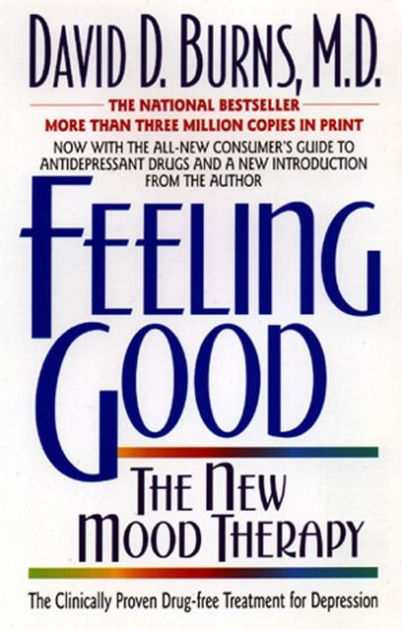Have you ever felt stuck in a cycle of negative thoughts, anxiety, or depression? You’re not alone. Millions of people grapple with these challenges daily. Fortunately, there’s a powerful tool that can help you break free: cognitive behavioral therapy (CBT). In his groundbreaking book, “Feeling Good: The New Mood Therapy,” renowned psychiatrist Dr. David Burns offers a practical and effective guide to understanding and overcoming emotional distress.

Image: www.scribd.com
This book, which has sold over 4 million copies worldwide, has become a cornerstone of self-help literature. Dr. Burns’s accessible writing style and evidence-based approach make CBT principles digestible and applicable for everyone. He empowers readers to become their own therapists, equipping them with the tools to identify and challenge negative thoughts, develop coping mechanisms, and ultimately lead happier, more fulfilling lives. Whether you’re seeking relief from mild anxiety or struggling with more severe mood disorders, “Feeling Good” can be a transformative resource for your mental well-being.
The Power of Cognitive Behavioral Therapy
Understanding the Connection Between Thoughts, Feelings, and Behaviors
At the heart of Dr. Burns’s approach is the fundamental principle that our thoughts, feelings, and behaviors are interconnected. Negative thoughts can lead to distressing feelings, which, in turn, can influence our actions. CBT focuses on breaking this cycle by helping us become aware of our thoughts and how they impact our emotions and behaviors.
Challenging Cognitive Distortions
Dr. Burns identifies ten common “cognitive distortions,” or irrational thinking patterns, that contribute to negative emotions. These include:
- All-or-Nothing Thinking: Viewing situations in extreme, black-and-white terms.
- Overgeneralization: Drawing sweeping conclusions based on a single event.
- Mental Filter: Focusing only on negative aspects and ignoring positive ones.
- Disqualifying the Positive: Dismissing positive experiences as insignificant.
- Jumping to Conclusions: Making assumptions without evidence.
- Magnification and Minimization: Exaggerating negative events and downplaying positive ones.
- Emotional Reasoning: Assuming that feelings reflect reality.
- Should Statements: Imposing rigid rules and expectations on yourself and others.
- Labeling: Assigning negative labels to yourself and others.
- Personalization: Blaming yourself for events that are outside your control.

Image: lessonmediafred.z13.web.core.windows.net
Developing Cognitive Restructuring Techniques
Once we become aware of these distorted thinking patterns, Dr. Burns provides practical strategies for challenging and restructuring them. These techniques include:
- Identifying and disputing negative thoughts: Questioning the validity of negative thoughts and replacing them with more realistic and balanced perspectives.
- Behavioral experiments: Testing the validity of negative beliefs through real-life experiences.
- Reframing: Viewing situations from a more positive or constructive lens.
- Developing coping mechanisms: Learning techniques for managing stress and anxiety.
Applying CBT Principles in Daily Life
“Feeling Good” is not simply a theoretical text; it’s a practical guide for transforming your daily life. Dr. Burns provides numerous exercises and worksheets throughout the book to help you apply CBT principles to specific situations. These exercises encourage self-reflection, challenge negative thought patterns, and develop coping strategies for common challenges like anxiety, depression, and interpersonal conflicts.
Examples of CBT Techniques in Action
Imagine you’re experiencing anxiety about a work presentation. Using CBT, you might:
- Identify the negative thought: “I’m going to mess up the presentation and everyone will think I’m incompetent.”
- Challenge the thought: “Is it really likely that I’ll completely fail? What evidence do I have to support this belief? What are some possible scenarios that could actually go well?”
- Reframe the thought: “It’s normal to feel nervous before a presentation, and I’ve prepared well. Even if I make a few mistakes, it’s not a reflection of my overall worth.”
- Practice relaxation techniques: Deep breathing exercises or mindfulness meditation to manage anxiety.
The Lasting Impact of “Feeling Good”
Dr. Burns’s work has had a profound impact on the field of mental health. His accessible approach to CBT has made this powerful therapy widely accessible, empowering individuals to take control of their emotional well-being. The book’s enduring popularity is a testament to its effectiveness and its relevance to the challenges we face in our daily lives.
Feeling Good Dr David Burns Pdf
Conclusion
“Feeling Good” by Dr. David Burns is a valuable resource for anyone seeking to understand and manage their emotions. By providing a clear and practical guide to cognitive behavioral therapy, it equips readers with the tools to identify and challenge negative thoughts, develop coping mechanisms, and lead happier, more fulfilling lives. If you’re ready to break free from negative thought patterns and unlock your potential for happiness, this book is an essential starting point.






